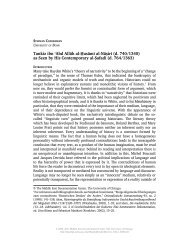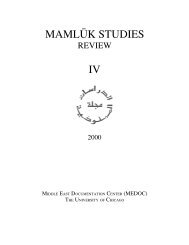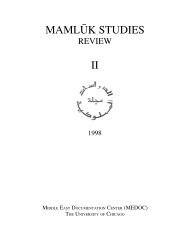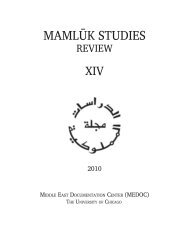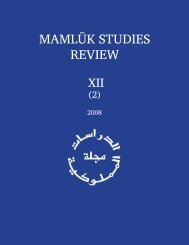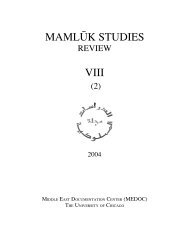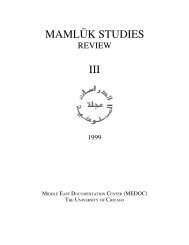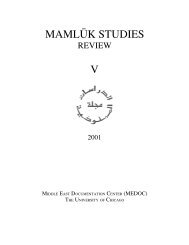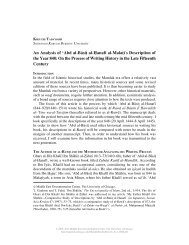Mamluk Studies Review Vol. VI (2002)
Mamluk Studies Review Vol. VI (2002)
Mamluk Studies Review Vol. VI (2002)
You also want an ePaper? Increase the reach of your titles
YUMPU automatically turns print PDFs into web optimized ePapers that Google loves.
32 STEPHAN CONERMANN AND SUAD SAGHBINI, AWLA≠D AL-NA≠S AS FOUNDERS<br />
The other documents to which we have access—two collections of papers<br />
concerning exchanges and sales—give us information about the subsequent fate<br />
of the waqf of Yah˝yá ibn T˛u≠gha≠n. 65 Twenty years after the original grant of<br />
870/1465 the son of the donor, Muh˝ammad al-Siba≠’|, and the primary executor,<br />
Kumushbughá ibn ‘Abd Alla≠h al-Timra≠z|, sold parts of these properties to two<br />
civilians. One share was then sold to a <strong>Mamluk</strong> daughter on behalf of and probably<br />
by order of her father in 890/1485. The other part was subsequently sold to a<br />
<strong>Mamluk</strong> son, Ibra≠h|m ibn Khushqadam, in 891/1486, and then transferred to a<br />
sultan's guard, i.e., a <strong>Mamluk</strong>, three years later. He in his turn, together with his<br />
wife, once again transformed the endowed property into a foundation in 898/1493.<br />
Diverse acts of sale, endowment, and exchange thus complement each other<br />
and serve as a blueprint for the understanding of <strong>Mamluk</strong> land and capital policies,<br />
especially in the Circassian period. The transitory ownership of land illustrates the<br />
ready availability of real estate, even though some of it should actually have<br />
remained non-negotiable as waqf indefinitely. Contrary to strict shari‘ah regulations<br />
it was, as already mentioned, common to release endowed property from its waqf<br />
stricture. In view of the shortage of freely disposable land only this kept the<br />
Egyptian property market afloat in the ninth/fifteenth century.<br />
Above all, we are shown a less stratified society in which not all real estate<br />
transactions ended up in the hands of the powerful <strong>Mamluk</strong> elite. Rather, one<br />
gains the impression that <strong>Mamluk</strong> descendants were important mediators, brokers,<br />
and quite frequently also fronts in such transactions. The awla≠d al-na≠s represented<br />
a mobile intermediary group between the ruling <strong>Mamluk</strong> caste and the local elite.<br />
Together with the eunuchs 66 they form a group of extreme importance for the<br />
understanding of Egypto-Syrian society during <strong>Mamluk</strong> times. Their role as<br />
mediators calls into question the notion of a rigid social dichotomy. The <strong>Mamluk</strong><br />
principle was compromised at several levels so that <strong>Mamluk</strong> sons not only had the<br />
opportunity to share power with <strong>Mamluk</strong>s on an individual basis, but can even be<br />
perceived as a distinct group in their own right. In conclusion it is to be hoped that<br />
<strong>Mamluk</strong> progeny and their hybrid culture will continue to be of interest, especially<br />
since the extant material offers ample scope for further research.<br />
65 One can find these documents in Am|n's catalogue as no. 389 and no. 525. Am|n, Fihrist,<br />
113–14 and 146–47. The registration numbers of the Ministry of Pious Foundation in Cairo are<br />
493 j|m and 665 j|m. We are preparing these documents for publication. Stephan Conermann and<br />
Souad Saghbini, "Mamlu≠kensöhne (awla≠d an-na≠s) als Stifter und Landbesitzer: Ein Fall aus dem<br />
9./15. Jahrhundert," in Conermann and Pistor-Hatam, eds., Studien zur Geschichte und Kultur der<br />
<strong>Mamluk</strong>enzeit.<br />
66 On the role of eunuchs, David Ayalon's "The Eunuchs in the <strong>Mamluk</strong> Sultanate" remains<br />
authoritative. See <strong>Studies</strong> in Memory of Gaston Wiet, ed. M. Rosen-Ayalon (Jerusalem, 1977),<br />
267–95.<br />
© <strong>2002</strong>, 2012 Middle East Documentation Center, The University of Chicago.<br />
http://mamluk.uchicago.edu/<strong>Mamluk</strong><strong>Studies</strong><strong>Review</strong>_<strong>VI</strong>_<strong>2002</strong>.pdf



